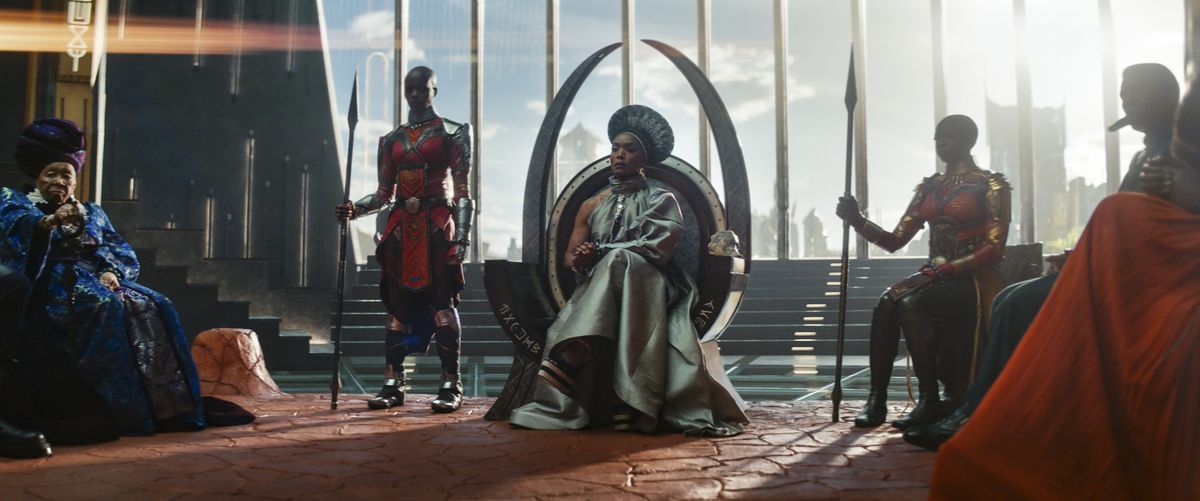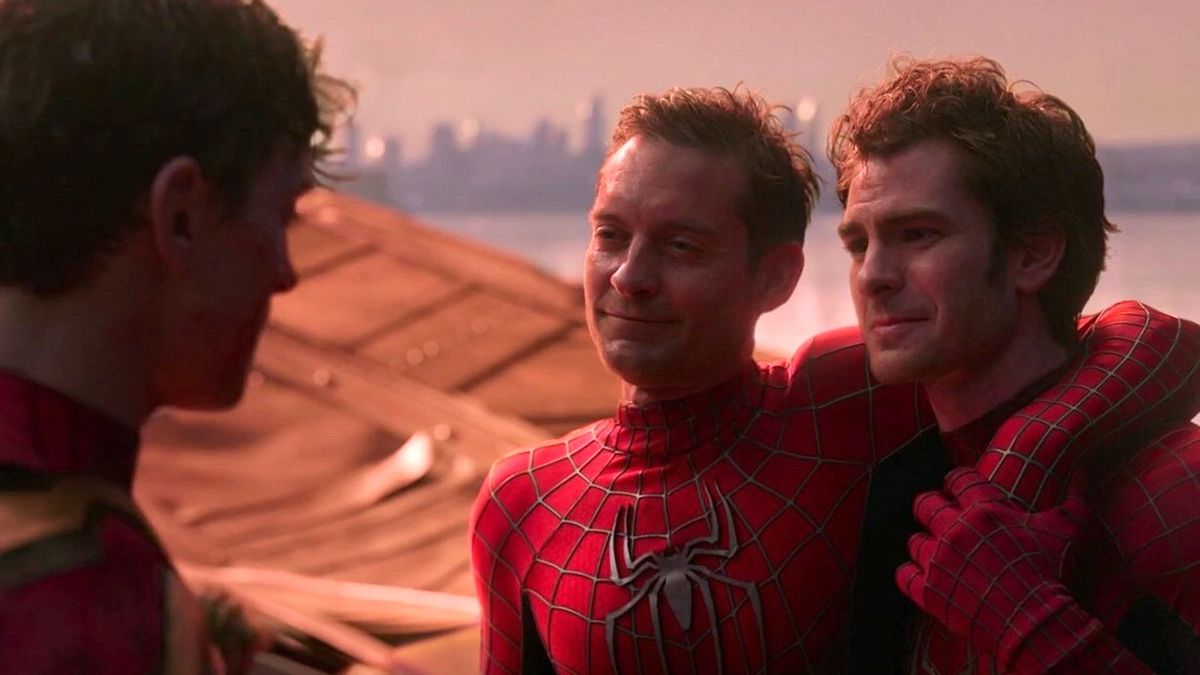Black Panther: Wakanda Forever and The Guardians of the Galaxy Holiday Special have closed out Phase 4 of the Marvel Cinematic Universe — the shortest, longest, weirdest phase yet in Marvel Studios’ ongoing experiment in building a cinematic dynasty. It’s the shortest, because pandemic delays meant it lasted less than two full years, but the longest because it encompassed seven movies, eight TV series, and two one-off specials.
And it’s the weirdest, because in addition to introducing a mind-bending multiverse, it came the closest to responding to a longtime MCU critique: the ways the studio runs roughshod over distinctive filmmaking voices. Phase 4 was retroactively branded as the first act of the Multiverse Saga, but really, Phase 4 was the Filmmaker Phase — and Marvel may have been unprepared for the demands of the project at hand.
On the movie side, at least, this was the MCU’s most eclectic director lineup ever. Their new additions included the franchise’s first solo female director, Cate Shortland (Black Widow); Chloé Zhao (Eternals), fresh off an Oscar win; experienced studio stylist Sam Raimi (Doctor Strange in the Multiverse of Madness); and Destin Daniel Cretton (Shang-Chi), who comes from a background in human-scale dramas like Short Term 12. Among the three directors it brought back for sequels, Taika Waititi (Thor: Love and Thunder) and Ryan Coogler (Wakanda Forever) are the two clearest and most immediately recognizable voices from Phase 3.
Photo: Jasin Boland/Marvel Studios
By contrast, nearly half of Phase 3’s movies were directed by either the Russo Brothers, or Jon Watts, who also helmed Phase 4’s Spider-Man: No Way Home. (And in the meantime, the Russos conducted a parallel counter-experiment in their own post-Avengers filmmaking, and came up with the abysmal Cherry and the witless The Gray Man.)
Phase 4 was the perfect time to experiment more broadly with what directors with strong, specific, unique voices might bring to the screen. Suddenly freed from the long march toward the climax of the Infinity Saga, Marvel could relax and play around with its remaining familiar characters, introduce crucial new ones, and do more of both through a steady stream of TV shows. Sure, Endgame had a series-finale vibe, but it also left this vast world of interconnected characters feeling more open for interpretation than it had in a decade, since the era when the first installments of Iron Man, Thor, and Captain America all felt decidedly different from each other, before the real formation of a Marvel House Style. Just as Joe Johnston doesn’t share much common ground with Kenneth Branagh, few attentive viewers could easily mistake mordant Sam Raimi slapstick for Ryan Coogler’s emotional grandeur.
So why did so many fans and critics spend so much time diagnosing how Phase 4 went wrong?
Doubtless some Marvel faithfuls would accuse the studio of not exerting enough control at this early stage of the Multiverse Saga — of letting the master story ramble around the multiverse, rather than immediately gathering velocity and gravitas. And maybe the notion of spotlighting distinctive filmmakers is fundamentally incompatible with making a long-running series of interconnected superhero movies.

Image: Marvel Studios
Just look at the DC movies released over any given similar two-year stretch. Sometimes, they seem genuinely eclectic and filmmaker-driven. Just as often, they seem to be running in four or five different directions at once, with different people playing the same characters in strikingly different movies just a few years apart. A multiverse seems to invite that kind of chaos; shouldn’t Marvel therefore be reining it in, at least enough to give it some sense of focus and coherence?
Movies like Eternals, Thor: Love and Thunder, and Black Panther: Wakanda Forever certainly appear to make the case for better reconciliation between filmmakers and the studio. Chloé Zhao’s Eternals keeps trying to drift away from superhero origin routines as it attempts to bring Zhao’s reflective poetry to Gods of Egypt-style historical-fantasy soap. Zhao doesn’t have much facility with the CG-haze climaxes, or the listless punch-up laughs that are supposed to lighten the mood.
Love and Thunder has more faith in its punchlines — Taika Waititi is one of the few MCU filmmakers who actually seems invested in comedy, rather than programming it in at required intervals. But with Love and Thunder, he pursues his gags with such overconfident zeal that he undermines the story and the characters. It’s a prime example of a place where letting a filmmaker’s voice dominate over basic storytelling, resulting in a film that doesn’t serve the MCU’s overall arc, or the film’s characters as they’ve been established.
On the other side of the equation, the need to fit into a giant narrative doesn’t particularly serve the needs of artists whose voices are their primary assets. Wakanda Forever may qualify as the MCU’s biggest recent disappointment from an artistic perspective. Coogler brought such depth of feeling and graceful image-making to Black Panther, but the sequel’s need to preserve and establish an ongoing narrative means it’s overstuffed with exposition, canned conflicts over the futility of revenge, and characters who don’t get to do anything, because their arcs are being saved for future installments.

Image: Marvel Studios
Still, just as nearly everything interesting about Wakanda Forever feels like Coogler, almost all of Phase 4’s standout elements can be credited to the specific filmmakers hired for this experiment, rather than to the usual Marvel Studios elements. While Doctor Strange in the Multiverse of Madness had to retcon or repair some of what went down during WandaVision, it also carried a the thrilling sense that we might actually be watching Sam Raimi’s interpretations of Stephen Strange and Scarlet Witch, even when Raimi himself downplayed his say over the film, and described himself as an enthusiastic hired hand. The MCU version of Strange has sometimes come across as a disdainful stiff. How better to visualize that than by temporarily forcing him into an actual decaying body? And how better to curtail endless crossover teases than a scene where Wanda systematically dispatches a row of big-character cameos? Another MCU director might well have agreed to do these scenes, but it’s hard to picture others putting them across with the same verve Raimi brings to the table.
The stylistic departures of Cate Shortland’s Black Widow are subtler. The movie was largely dismissed as a postscript to Natasha Romanoff’s story, though it also set up some characters designed to be used in future shows or movies. But Shortland lends the movie a surprising amount of visual texture, with evocative close-ups, environments that don’t feel as washed-out as some MCU movies, and a fitting ruefulness to the human interactions. As much as the story fits neatly into a particular point in the MCU’s timeline, Black Widow doesn’t feel especially beholden to its larger connections. It’s a story about a character fans already like, but a story that wouldn’t make sense to tell in the context of an Avengers movie. It’s just a shame that Marvel Studios apparently didn’t realize it even could tell that kind of story about Natasha until the character was already dead.
An MCU that all looks more like the relatively standalone spy thriller Black Widow, the tilted yet sincere goofiness of Multiverse of Madness, or the most grief-streaked parts of Wakanda Forever would not necessarily be more fan-pleasing or financially successful than the programmatic blockbusters that made the MCU’s reputation. (Although when a film is considered a failure for a mere $300 million domestic box office take, the problem is more with the financial model than with the film.) But these are the elements of Phase 4 that feel like movies, rather than tendrils of a franchise.
Phase 4’s biggest hit, Spider-Man: No Way Home, offers the nostalgic kick of seeing three different versions of Spider-Man inhabit the same on-screen space. But its title is correct: This kind of magic trick can only really be pulled off once before audiences demand something bigger, better, and flashier — but also comfortingly familiar, because fans’ imaginations tend to conjure up hopes and dreams based on what they’ve already seen and loved, especially when contemporary franchises encourage them to think purely in terms of their longtime faves.

Photo: Marvel Studios/Columbia Pictures
That tension between serialized familiarity and individualized variations has been a part of the MCU since the beginning. Back in the days of the first Iron Man movies, the Marvel Cinematic Universe component of long-term filmmaking planning was new, and the Robert Downey Jr. as the hotshot, motormouthed movie star at its center provided the sense of audience familiarity.
But Phase 4, lacking the self-reflexive team-up event status of Avengers movies or the instant freshness of something like the original Iron Man or Black Panther, has brought that conflict to a head more explicitly than ever before. Even without an eclectic roster of big-name filmmakers, the TV shows have similarly flitted between experimentation (WandaVision, Loki, What If…?) and comfort (The Falcon and the Winter Soldier and Hawkeye). Sometimes they strike a fine balance, as in Ms. Marvel, a show that’s part of the MCU without being subsumed by it. (Like Black Panther, it has a whole world of characters who seem wholly uninterested in crossing over into the main storyline to trade quips with Ant-Man.) At other times, they land awkwardly in the middle — She-Hulk seemed to be made with the intention to subvert MCU conventions through the language of sitcoms and old legal dramas, but without the production team actually paying attention to the forms of those shows.
With the sheer volume of Marvel stuff available, it shouldn’t count as a grave disappointment when some movies or TV shows don’t quite work for every fan. That’s part of why the Filmmaker Phase was necessary. If anything, Phase 4 didn’t go far enough in acclimating viewers to the idea that with this many Marvel properties hitting screens, it’s fine for some of them to traffic in unexpected elements, beyond the kinds of twists and turns that require spoiler warnings. (Werewolf By Night possibly went furthest in establishing that even an MCU canon-compliant project can have a unique flavor and approach that won’t land for every viewer. More of those kinds of far-out projects will likely expand fans’ expectations, particularly with the sheer volume of new material coming to screens.)
As the MCU has become more graceful in its integrations of multiple characters, franchises, or even dimensions (remember that awkwardly inserted Hawkeye tease in the first Thor?), the movies have appeared more technically constricted. That’s how you get washed-out white skies in a Sam Raimi thrill ride, or a murky CG-choked climax to Shang-Chi, a movie shot by the cinematographer of Scott Pilgrim vs. the World and Alita: Battle Angel. This widely varying group of filmmakers could only collectively bend the Marvel boundaries so far. It’s possible that the studio just doesn’t want anyone to go further. (It’s certainly arguable that no one inclined to do so would bother taking the job.) But every game can’t be an endgame. Marvel had to at least try to expand its boundaries, or die trying. The results show that giving unique filmmakers a voice in the MCU is always going to be a struggle — but even if some battles are destined to be lost, the fight is still worth waging.

